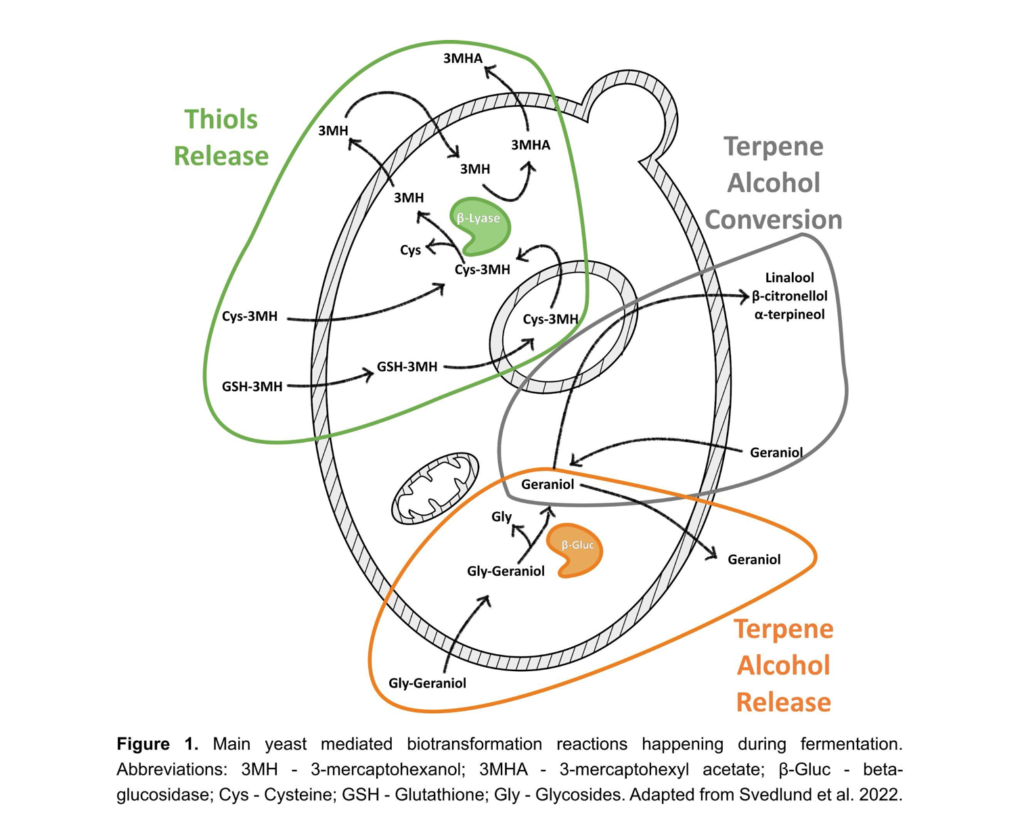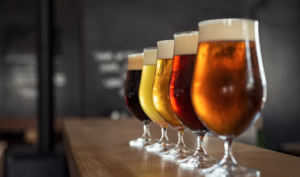Biotransformation is a legitimately exciting beer trend. Here, White Labs explain why.
Tropical flavours. Fruit bomb beers. Unlocking bound thiols. These are buzz phrases often tossed around whenever the topic turns to biotransformation.
In reality, biotransformation of hop compounds by yeast strains in beer is a fascinating and multifaceted process – one being embraced with great excitement and enthusiasm.
Brewers are right to be intrigued, given the clear potential to optimize the use of hops and create evermore diverse and desirable beers.
During fermentation, biotransformation occurs when some yeast-derived enzymes convert odorless and flavourless hop precursors into desirable flavours and aromas (Fig.1), making it particularly relevant for popular styles like the juicy and fruity IPAs.
Research on this subject is constantly emerging, with much of the knowledge being borrowed from the wine industry. This complex process involves three main reactions: i) Terpene alcohol release and ii) conversion, and iii) Thiol release.
The main contribution of biotransformation to the final beer is the release of flavour active molecules, like monoterpene alcohols and thiols, from their non-aromatic precursors performed by two yeast-encoded enzymes, β-glucosidase and β-lyase.
The conversion between different hop-derived terpene alcohol, like geraniol and linalool, can also moderately contribute to the final product flavour profile. This process, though not fully understood, is also thought to be enzyme mediated.
The enzyme β-glucosidase releases the aromatic terpene alcohols from a non-aromatic glycoside precursor, such as geraniol from geranyl glycoside.
This enzyme is not produced by most brewing strains, being more commonly present in yeast of the Brettanomyces and Pichia genus, thus the impact of this enzyme is reduced in most beers.
Furthermore, the terpene alcohols flavour threshold is reasonably high (ppm to ppb), so a considerable amount of molecules need to be released into the beer before its impact is perceived.
For that reason, the main focus of brewers and winemakers all around the world is in the reaction performed by the enzyme β-lyase, also known as cysteine S-conjugate beta-lyase.
During fermentation, this enzyme releases volatile thiols that contribute notes of passion fruit and grapefruit from precursors present in malt and certain hop varieties.
Unlike terpene alcohols, these volatile free-thiols can be detected at extremely low levels, in the parts per trillion range, so any small increase is likely to be detected by the consumer.
Some of these compounds, namely 3-mercaptohexan-1-ol (3MH), 3-mercaptohexyl acetate (3MHA), and 4-methyl-4-mercaptopentan-2-one (4MMP), are known to contribute tropical qualities to the beer aroma.
Not all yeasts are created alike, and only yeast strains that present a functional version of the IRC7 gene are capable of performing this reaction.
At White Labs we screened our entire yeast collection for the presence of this enzyme activity, and developed a blended culture of several high activity strains (WLP077 Tropicale Yeast Blend) to produce a beer with tropical characteristics.
Nevertheless, this gene is tightly regulated by wort composition, particularly Free Amino Nitrogen (FAN) content, and only when FAN levels drop below a certain threshold will the yeast present this activity.
To try to circumvent this limitation, brewers can manipulate the FAN content in the beer, change the hop additions to maximize precursors or try to apply one of the commercially available genetically modified (GMO) strains with continuous activity of the enzyme.
Hops, as the main source of bound-thiol precursors, also need some consideration as each hop variety contains different types and amounts of compounds that will impact the final flavour profile of the beer.
Some of the most popular hop varieties, like Citra, contribute high amounts of volatile thiols to the beer and do not benefit significantly from biotransformation.
On the other hand, more traditional varieties like Cascade, Saaz or Simcoe contain higher amounts of thiols in the bound and non-aromatic form. Such hop varieties particularly benefit from interaction with high β-lyase activity yeast strains to achieve tropical aroma profiles.
The challenge for the brewers is then to provide the selected yeast strain with plenty of precursors, so that the final product presents an improved aroma and flavour.
Introducing hops during the mash and focusing on whirlpool and fermentation hop additions are some of the most popular approaches.
Some recent research indicates that whirlpool additions significantly contribute to increased precursor concentration in wort, and that cold storage might be necessary for the release of a significant portion of the volatile thiols back into the beer.
Thiol precursors can also be introduced in the brewing process from other sources, namely grape derivative products like Phantasm or even malt, increasing the overall impact in flavour and aroma.
The impact of all these new ingredients and techniques is still being assessed, with new information becoming available all the time. Stay tuned!










